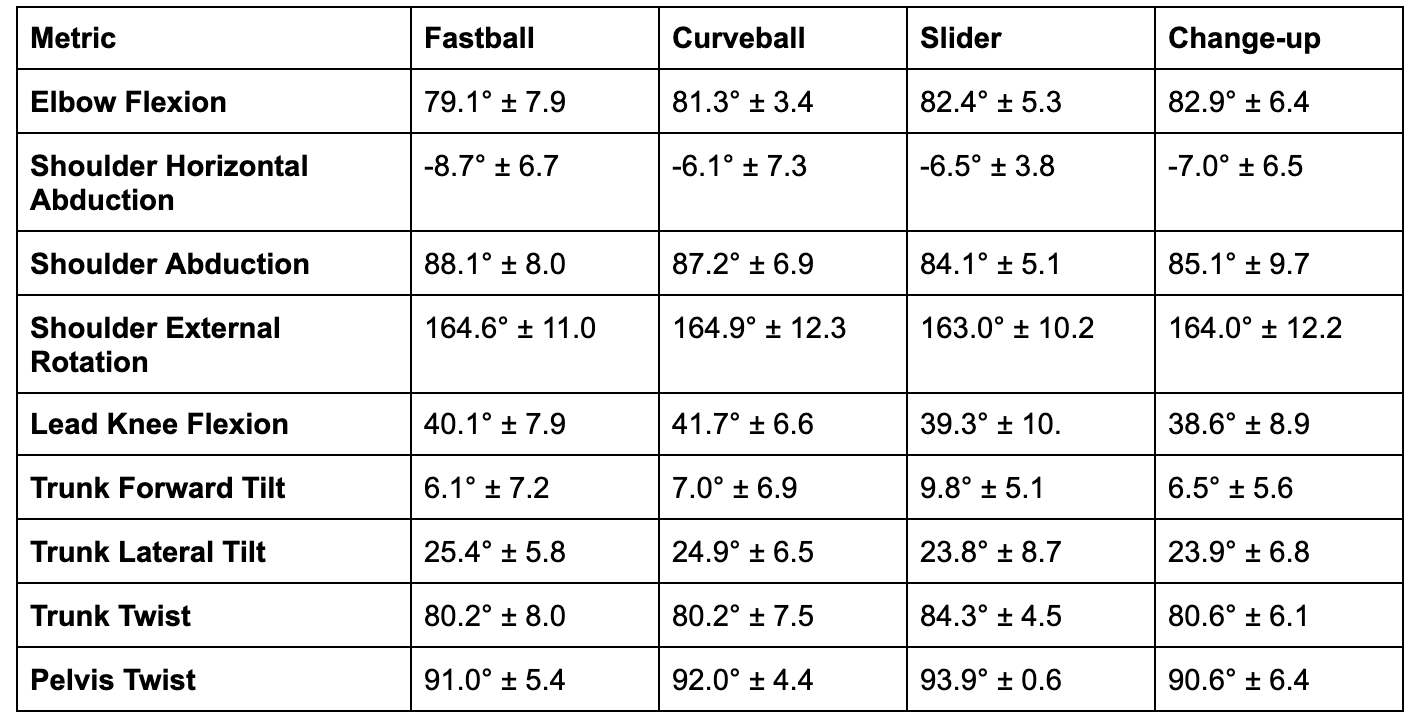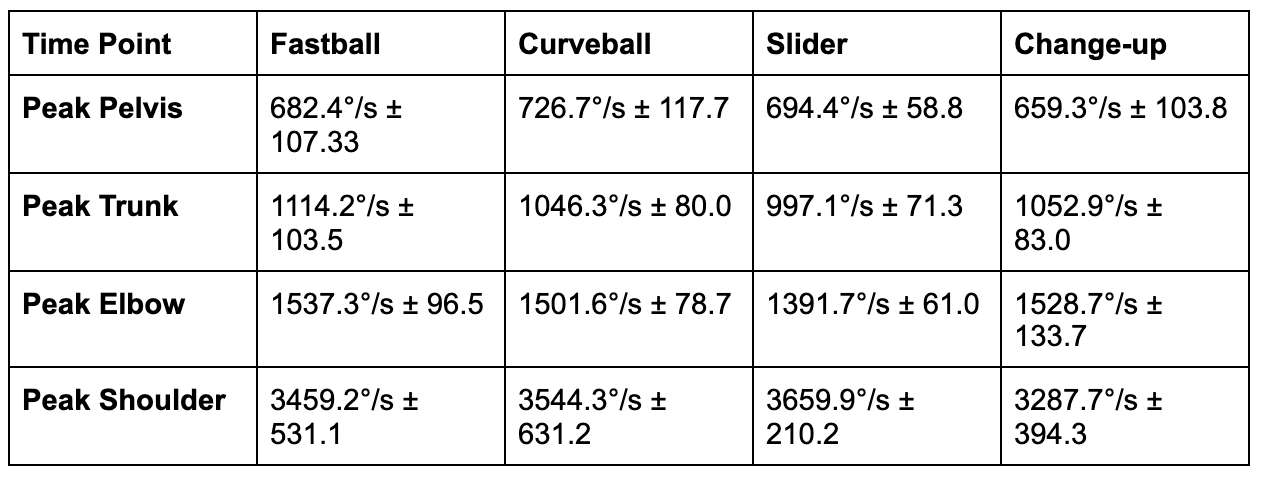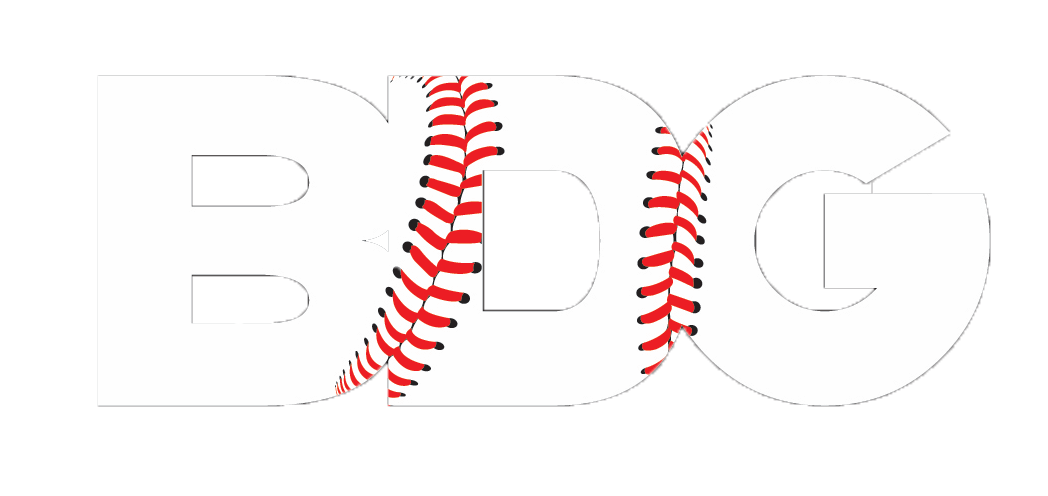Kinematic Differences Between Pitch Types: PitchAI Testing
Introdution
This blog post is a follow-up to Kinematic Differences Between Pitch Types: What We Know So Far, where we discussed previous literature investigating differences in pitching mechanics between pitch types. In this project, we aimed to replicate the findings in the studies synthesized in the previous post, and also investigate some differences further using PitchAi.
Methods
Participants
There were five pitchers who participated in this study. Average age was 23 ± 4 years old. Average height was 183.86cm ± 10cm, and average weight was 90.54kg ± 11.20kg. All data was collected during normal bullpen sessions, and pitchers were not subject to any research interventions. Pitchers who were not comfortable throwing a type of offspeed pitch in this study did not throw that type of pitch.
Data Collection
All pitches were thrown from a rubber indoor mound to a target at the regulation distance of 60.5ft. The camera position was 4m from the middle of the mound, 0.9m down the mound, and on a tripod 1.1m tall. Videos were recorded on an iPhone 12 Pro at 240Hz and 1080p.
Results
Average Ball Velocities and Arm Speed

Time Point Angles
Foot Plant

Maximum External Rotation

Ball Release

Angular Velocities
Peak Joint Angular Velocities

Relative Timings as a Percentage of Pitch Cycle (FP to BR, 0-100%)

Full Signal Velocities
Elbow Extension
Fastballs and change-ups had the greatest elbow extension velocities (1537.34°/s, 1528.69°/s), then curveballs at 1501.64°/s, while sliders had the slowest at 1391.71°/s. Change-ups and curveballs had the latest elbow extension velocities (84.2%, 84.0%), while sliders and fastballs had similar timings (79.2%, 78.3%). The later timing of change-ups and curveballs may be partially explained by pitchers relying on more of a dart-like arm action to generate the 6:00 spin direction on curveballs. This kinematic difference does not exactly match up with the concept of change-ups having an ideal spin direction of around 3:00, as previous research indicated that change-ups tended to be thrown from lower arm slots to generate the 3:00 spin direction. With a more dart-like arm action, this would likely generate more of a 12:00 spin direction, unless the player has a more ulnarly deviated wrist at release to generate the 3:00 spin direction.

Shoulder Internal Rotation
Shoulder internal rotation velocities were fairly similar between pitch types, however sliders were the fastest at 3659.94°/s, followed by curveballs at 3544.30°/s and fastballs at 3459.24°/s, with change-ups being slowest at 3287.69°/s. The timings between each peak were between 102% and 105% for all pitch types, with change-ups being the latest, and sliders and curveballs being the earliest. These differences may be explained by pitchers relying more on arm action to generate spin on sliders and curveballs, and to kill velocity on the change-up. Fastballs seem to be the outlier here as they are middle of the pack, however there are other kinematic differences with fastballs that may explain why the shoulder internal rotation velocities may be lower than the breaking pitches.

Trunk Rotation
In general, fastballs had the greatest trunk rotational velocity at 1114.21°/s, then change-ups and curveballs at 1052.91°/s and 1046.33°/s, and sliders were the slowest at 997.13°/s. The relative timings of the peak trunk rotation were latest for fastballs at 44.7% and change-ups (46.0%), with sliders (39.1%) and curveballs (36.1%) being earlier. With trunk rotational velocity being a large component of velocity, it is no surprise to see fastballs being the highest with the latest relative timing.

Pelvis Rotation
Curveballs had the fastest and earliest pelvis velocity at 726.72°/s and 14.9%, then sliders at 694.43°/s and 16.5%, then fastballs at 682.38°/s and 19.1%, and change-ups being the slowest and latest at 659.34°/s and 21.1%.

Lead Knee Extension
For lead knee velocities, the fastballs and sliders tended to follow similar trends, and the change-ups and curveballs were similar to each other as well. Sliders were the fastest at ball release at 270.57°/s, then fastballs at 224.22°/s, curveballs were at 219.90°/s, and change-ups were slowest at 131.84°/s. Similar to the literature, there was not much dispersion at foot plant ranges from fastballs and curveballs at 46°, then change-ups at 44°, and sliders at 42°. Fastballs went through the greatest range of motion from foot plant to ball release at 14.5°, then sliders and curveballs at 11.8° and 11.6°, and change-ups at 9.5°. In general, it seems like pitchers were softer on their front side while throwing change-ups as their knee extension velocities were the lowest, and their total range of motion from foot plant to ball release was the least as well.

PitchAI Metrics

Stride length is the distance the pitcher strides measured from the starting position of their rear foot to the landing position of their stride foot at foot plant. This metric is presented as a percentage of pitcher height. Each pitch was very similar in this metric, however change-ups appear to have a slightly shorter stride length on average.
Time visible is a measure of deception, as it is the approximate time that the ball is visible to the hitter during the pitching delivery. Fastballs on average were visible for the least amount of time, followed by curveballs and change-ups, but sliders were visible for almost 10ms more during the delivery.
Elbow torque is a predictive model in this data processing, however we saw very similar trends to the literature where fastballs generated the highest elbow torque, then the offspeed pitches were all similar. These numbers are slightly higher than what is reported in the literature, however the trends are very similar.
Discussion
In general, our findings were similar to the significant trends reported in the literature; for more on what has been found, check out part 1 of this blog series. For trunk lateral tilt at ball release, the literature reported fastballs at 21°, we found 22.3°, sliders at 17°, we averaged 19.7°, curveballs at 24°, we averaged 21.6°, and change-ups at 19°, and we averaged 20.1°. Forward trunk tilt at ball release we saw similar trends as well, with literature stating fastballs at 36°, sliders at 34°, curveballs at 37°, and change-ups at 31°. We had similar findings with fastballs at 34.4°, sliders at 37.5°, curveballs at 34.5°, and change-ups also at 31.9°. Trunk rotational velocities were also similar, though we saw slightly different trends. Literature had fastballs reported at 1080°/s, sliders at 1060°/s, curveballs at 1055°/s, and change-ups at 1025°/s. We found fastballs to be at 1114.21°/s, sliders at 997.13°/s, curveballs at 1046.33°/s, and change-ups at 1052.91°/s. The fastball trunk velocities were very similar, but our slider findings were low in comparison. Regarding trunk tilt, again fastballs and curveballs had more lateral trunk tilt at release, compared to sliders and change-ups. This follows the ideology that more trunk tilt may allow the pitcher to generate a more vertical spin direction on the fastball and curveball, and a more horizontal spin direction on the change-up and slider.
For lead knee metrics, our findings had fastballs and curveballs landing with the most bent knee at around 46°, then change-ups at around 44°, and sliders the straightest at about 42°. At ball release we found fastballs to average around 32.5°, sliders around 30.5°, and curveballs and change-ups at 35°. Again our trends are similar to the literature with fastballs having the greatest range of motion and also straighter at release than change-ups and sliders, but sliders seemed to be an outlier again as they had been reported at a lead knee angle around 38° at release. Similar to what was stated in the previous blog post, the lead knee tended to be the most active for fastballs, indicating a likely better lead leg block, and better transfer of momentum through the body.
Elbow metrics also followed similar trends, however our magnitudes were lower for angular velocities, and different for elbow torque. For angular velocities, fastballs averaged 1537°/s, compared to 1925°/s and 2317.6°/s, curveballs averaged 1501°/s, compared to 1841°/s and 2226.2°/s, and change-ups averaged 1528°/s, compared to 2141.8°/s. Sliders in our study had the lowest elbow extension velocity at 1391°/s compared to 2040°/s. Sliders were also an outlier for elbow angle at ball release, as they averaged around 40°, compared to 32°, with fastballs averaging 31°, curveballs averaging 32°, and change-ups averaging about 34°. Those elbow angles at release were very similar to Escamilla et al., 2017. Elbow torques averaged 77.4Nm for fastballs, 74.2Nm for curveballs, 73.9Nm for sliders, and 73.3Nm for change-ups. Escamilla et al., 2017 found fastballs at 96 ± 17Nm, sliders averaged 95 ± 14Nm, curveballs averaged 92 ± 18Nm, and change-ups averaged 88 ± 11Nm. Our numbers are more comparable to Fleisig et al., 2016, with fastballs at 71.5Nm, curveballs at 67.4Nm, and change-ups at 63.1Nm. In general, we saw the same trend with fastballs having the highest torque values, then the breaking pitches, then change-ups, however we did not see as large a range in change between pitches as previous research.
Shoulder metrics were similar to the literature as well. Our shoulder internal rotation velocities were generally low compared to Escamilla et al., 2017 (~6250°/s to ~6750°/s) and Fleisig et al., 2016 (~6250°/s to ~6950°/s), but were very similar to Nissen et al., 2009 (~3400°/s to ~3650°/s). In general, previous research had fastballs with the greatest internal rotation velocities, then sliders and curveballs, then change-ups. We saw sliders the fastest at 3660°/s, then curveballs at 3544°/s, then fastballs at 3460°/s, and change-ups at 3290°/s. The relative timing of shoulder internal rotation matched very well with results from Escamilla et al., 2017, as fastballs were at 103.1%, curveballs at 102.3%, sliders at 102.7%, and change-ups at 105.3%.
Pelvis metrics varied more than literature, as we found much higher pelvis rotational velocities compared to Escamilla et al., 2017. Fastballs were 682°/s, compared to 540°/s, curveballs were 726°/s, compared to 505°/s, sliders were 694°/s, compared to 520°/s, and change-ups were 659°/s, compared to 500°/s. Our relative timings were also much earlier with fastballs at 19%, curveballs at 15%, sliders at 16.5%, and change-ups at 21%. Escamilla found these to be 33% for fastballs, 35% for curveballs, 36% for sliders, and 29% for change-ups.
Although our trends were generally similar to what has been previously found, our magnitudes were slightly different, and our timing metrics were fundamentally different. Magnitude differences compared to literature may be due to skill level and velocity differences but may also be due to processing differences between studies. For timing metrics, PitchAi uses an algorithm to determine foot plant, which occurs slightly after initial foot contact. This causes our normalized timing to start later than the studies that use foot contact to initiate their normalization. This difference may explain some of the differences in pelvis timing, explaining why our values were much smaller than Escamilla et al., 2017. Our group was smaller with only five pitchers, and they were not entirely comfortable with throwing sliders, as one pitcher did not throw any sliders for this analysis. Potential other factors that may account for our differences compared to the literature are the tracking and processing of PitchAI. Segment definitions and joint angles and angular velocities may also be defined and calculated differently between our study and previous research.
Sliders were less studied in literature as there was only one study that included them, giving us less data to compare with. More research still needs to be done on sliders, especially accounting for hand position on the baseball and the effects on spin direction and pitch velocity. Sliders are also different from curveballs and change-ups as there tends to be more variability across slider spin profiles. Generally, curveballs tend to have a higher spin efficiency and as close to 6:00 spin direction as possible, and change-ups tend to have more spin efficiency than curveballs, but approach a 3:00 (for RHP) spin direction ideally. Sliders tend to have the lowest spin efficiency, as gyro sliders can have less than 10%, while a topspin and sidespin slider can be around 35%. The ideal spin direction for a RHP on each of these sliders is between 10:00 to 12:00.
Conclusion
In summary, our data from PitchAI was very comparable to the literature, however there were some differences in magnitudes and relative timings of joint angular velocities due to differences in data capture and processing. We found that change-ups were generally slower and more delayed with joint angular velocities, where curveballs and sliders were fastest and earliest, and fastballs were somewhere in the middle. This means that players are slowing down their mechanics for change-ups, but moving faster for the breaking pitches. This may be due to the lower and earlier trunk velocities seen in sliders and curveballs, which alters the mechanics to rely on arm action and arm speed for velocity and spin development. The trunk may be slower and earlier for the breaking pitches due to the mental mindset of a breaking pitch, with the goal movement profile breaking down and towards the gloveside which may be achieved by opening the trunk earlier. For future pitch design coaching, there may be coachable kinematic changes that can alter pitching mechanics to generate different pitch profiles, however this still needs to be investigated.
